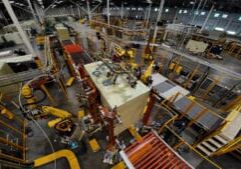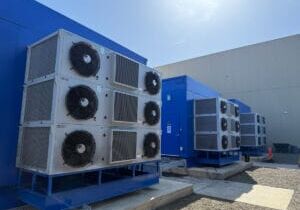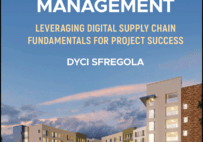Artificial Intelligence: Yes, it is a Construction Game-Changer

Anirban Basu is Chairman & CEO of Sage Policy Group and Chief Economist of the Modular Building Institute.
This is for Real
In 2023, the U.S. construction industry, valued at nearly $2 trillion, began embracing artificial intelligence (AI) to tackle several of its most pressing challenges. These include labor shortages, increasing efficiency, and enhancing worker safety.
Much like other sectors of the economy, AI is reshaping construction, revolutionizing how projects are planned and executed across the country. While it is obvious that AI cannot do certain things by itself, like laying bricks, paving roads, or shingling roofs, its impact stands to be both massive and positive. Specifically, by integrating AI into project management, safety monitoring, autonomous machinery, and supply chain operations, the industry is positioned to boost productivity while cutting costs. America needs that as resource availability dissipates and need expands. Projections estimate that AI’s footprint in construction will grow from a bit more than $200 million in 2023 to more than $1.1 billion by 2028.
Where it has been introduced, AI is already generating significant impact on project management and planning. In the U.S., approximately 75 percent of construction projects experience delays, typically extending timelines by approximately 20 percent. These delays are often caused by factors beyond contractors’ control, including unpredictable weather, hiring challenges, unanticipated subcontractor capacity limitations, or material supply issues. AI’s predictive capabilities help mitigate these disruptions by analyzing historical data and comparing it to current conditions. This proactive approach allows stakeholders to adjust schedules and reallocate resources as needed, reducing delays by up to 25 percent in certain instances.
Building Information Modeling (BIM) is currently utilized in more than 60 percent of large-scale construction projects. AI-powered BIM enables teams to simulate the entire project lifecycle, reducing rework and enhancing design accuracy. Studies indicate that AI-enhanced BIM systems can reduce design errors by up to 40 percent. Additionally, real-time data analysis, combined with AI, helps track project progress and optimizes scheduling, cutting overall project time by 10 to 15 percent, allowing contractors to meet deadlines and stay under budget.
While that has obvious industry-wide implications, there are also implications at the microeconomic level. All things being equal, those contractors that strategize around AI and actually integrate it as fully as possible in product design and executions are likely to be more profitable, prestigious, enjoy greater pricing power for their services, and quickly acquire market share. But many contractors are likely to lack an AI strategy, in large measure because the technology can presently be characterized as esoteric and intimidating.
Toward Safer Work Sites
Worker safety remains a critical concern in the construction industry, where risks are substantially higher than in other segments. Nearly 1,000 construction-related deaths occur annually in the U.S. Predictive safety models powered by AI analyze data from past incidents, taking into account environmental conditions and worker behavior to flag potential hazards. This proactive approach significantly reduces the risk of accidents, with industry estimates suggesting workplace accidents could decrease by as much as 25 percent.
AI-powered wearables are also becoming popular, monitoring workers’ vitals and fatigue levels in real time. This allows supervisors to make informed decisions regarding whether to pull workers from tasks if they are at risk of injury due to exhaustion or other factors. Pasha Ameli, senior advisor at the Berkeley Research Group, notes, “AI-driven safety tools help reduce fatigue-related accidents, which are among the leading causes of workplace injuries.” The salience of AI in this context extends well beyond construction, encompassing departments of public works and those who work in various aspects of supply chains.
On projects associated with substantial scale, including large-scale public works, AI-powered drones provide aerial inspections, helping supervisors identify potential problems before they put workers or deadlines at risk. These drones ensure safety compliance and allow for real-time monitoring of hazardous areas. As AI advances, its ability to quickly detect and analyze risks makes projects safer while chiseling away unnecessary costs. By leveraging these tools, the construction industry is poised to make gigantic strides toward a safer, more efficient work environment, saving lives and reducing injury-related expenses in the process. Safer, more predictable work environments will also inure to the benefit of industry recruitment.
Necessity is the mother of invention, or in this instance, process change. Labor/skills shortages have induced many contractors to adopt AI-powered solutions, including autonomous machinery for handling repetitive or hazardous tasks. AI-controlled bulldozers, excavators, and trucks are already in use on project sites, reducing the need for workers engaged in dangerous roles while bolstering productivity. Studies indicate that autonomous machinery could reduce labor costs by up to 30 percent by the next decade.
AI is also transforming robotic construction. AI-powered robots are being used for tasks such as bricklaying, concrete pouring, and demolition. These robots offer greater precision and speed than traditional methods, leading to faster project completion and fewer errors. Atul Khanzode, Chief Technology Officer at DPR Construction, emphasizes, “AI and machine learning will help automate wasteful processes, improving both productivity and project outcomes in the next five years.”
When combined with 3D printing, AI presents a game-changing solution to the housing crisis. The technology enables the rapid construction of affordable homes with minimal waste, reducing building time by up to 60 percent and labor requirements by 70 percent. AI optimizes material use, automates design, and predicts potential construction challenges, ensuring efficient and sustainable projects. This technology allows for the creation of customizable, energy-efficient homes, addressing both cost and supply issues, particularly in regions facing severe housing shortages.
Final Word
AI is also able to contribute to mitigating the types of problems that has characterized construction delivery during the pandemic and immediate aftermath. AI can forecast disruptions in materials and equipment delivery, enabling contractors to adjust orders and timelines accordingly. Critically, AI can monitor global supply chains and weather conditions, forming predictions that help construction companies avoid bottlenecks. This can be the difference between a happy client and an unhappy one; between a lawsuit and idle attorneys. As if all this were insufficient, AI can be and is used to analyze supplier performance based on pricing, delivery speed, and reliability, supporting more timely materials delivery at the most advantageous prices. In short, the AI revolution is real and not to be ignored.
More from Modular Advantage
Resia: Breaking All the Rules
Resia Manufacturing, a division of U.S.-based Resia, is now offering prefabricated bathroom and kitchen components to industry partners. Its hybrid fabrication facility produces more precise bathroom and kitchen components (modules) faster and at lower cost than traditional construction. Here’s how Resia Manufacturing does it.
How LINQ Modular Innovates to Bring Modular To The Market in the UAE and Beyond
LINQ Modular, with an office and three manufacturing facilities in Dubai, is a modular firm based in United Arab Emirates. The company is on a mission: to break open the housing and construction markets in the Gulf Cooperation Council (GCC) area with modular.
ModMax: Redefining Modular Construction with Confidence and Precision
ModMax was born out of frustration—frustration with five persistent pain points in modular construction: Permitting bottlenecks. Production delays. Rigid designs. Disconnect between “the office” and the field. Lack of transparency and communication.
LifeArk: Disaster-Resilient Housing from Recycled Plastic and 100-year-old Technology
Wee compares LifeArk’s housing units to Yeti coolers, as they are built similarly. Each component takes 15 to 20 minutes to manufacture, has an R-value of 40, and includes molded slots and chases for wiring, plumbing, fire sprinklers, and other utilities.
Building the Future of Modular Edge Infrastructure
The edge data center market is expanding rapidly, driven by the surge in AI workloads, IoT adoption, and the need for localized compute power. In these environments, sustainability, scalability, and reliability are non-negotiable. Cooling is among the most complex challenges for operators—and one of the most decisive factors in long-term success.
Accelerating Light-Gauge Steel Construction: A Semi-Automated Digital Workflow for Off-Site Projects
For construction professionals, the message is clear. By adopting semi-automation and digitalization, companies can deliver projects faster, more accurately, and more profitably, while also building stronger collaboration across teams. The approach is not about replacing people with machines, but about empowering people with better tools and processes.
Why Modular Data Centers Are Gaining Momentum
Artificial intelligence, high-performance computing, and edge applications push the limits of traditional “stick-built” data centers. They take years build, often struggle with high density workloads, and aren’t optimized for deployments near end users. Modular data center platforms are purpose-built to address these challenges, offering flexibility and scalability to adapt to evolving technologies, while opening new opportunities for the modular construction industry.
Supply Chain Innovation in Action: 5 Habits Every Modular Leader Should Practice
By applying these principles to supply chain practices — collaborative planning, strategic procurement, scenario modeling, digital tools, and transparent forecasting — construction leaders can build value chains that are not just efficient and agile, but truly innovative.
Exploring the Role of Modular Integrated Construction (MiC) in Advancing Circular City Principles – A Survey of Stakeholder Perspectives
The survey findings highlight the significant potential of Modular integrated Construction (MiC) in advancing the development of circular cities. By reducing costs, accelerating construction timelines, and minimizing waste generation, MiC offers a promising approach to sustainable urban development.
The Use of MS POLYMER™-Based Sealants and Adhesives in Modular Building
These products combine flexibility and elastic recovery with excellent adhesion to different substrates and have already shown their usefulness in traditional construction. Now it’s time for them to be put to use in the modular construction industry.










